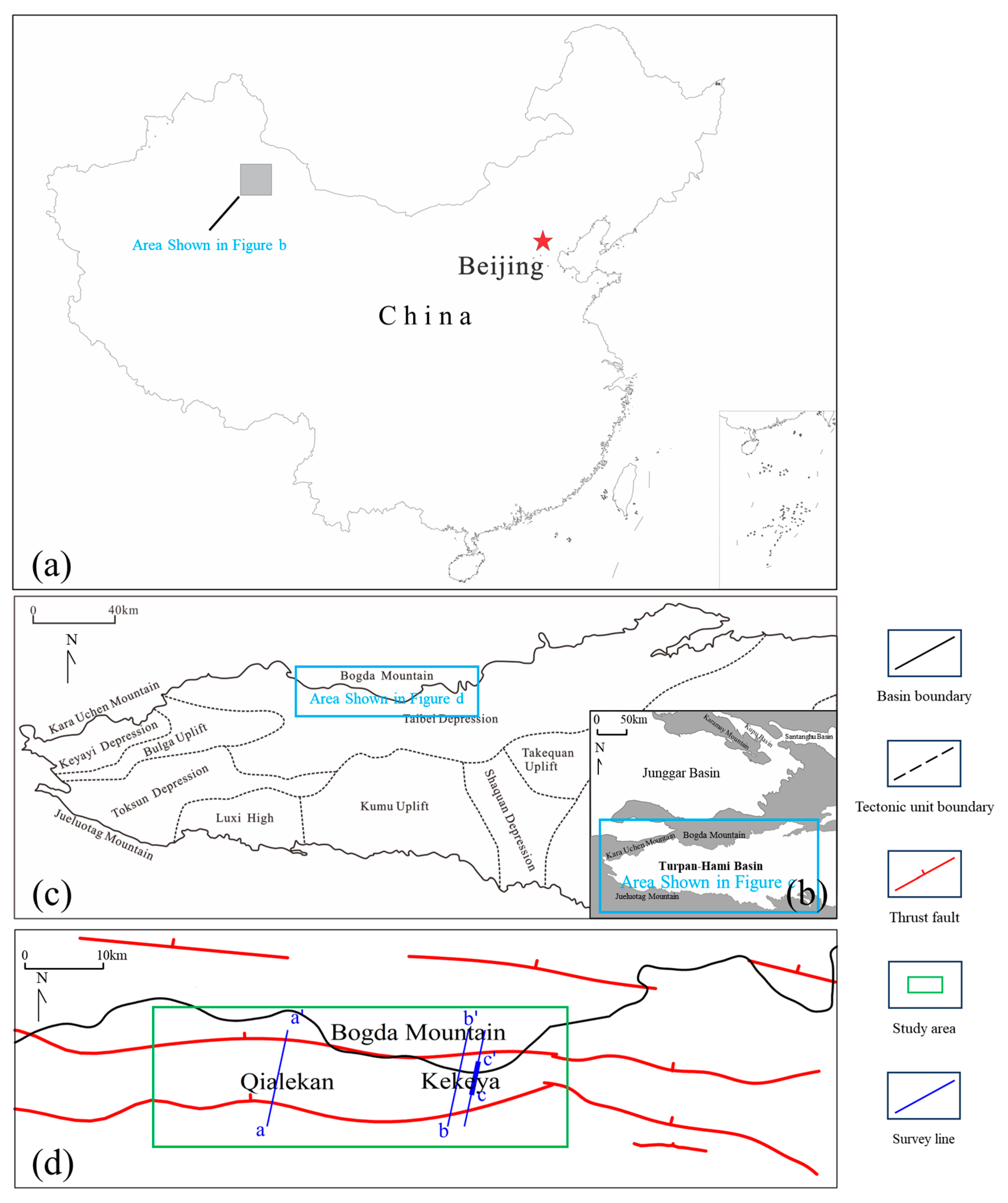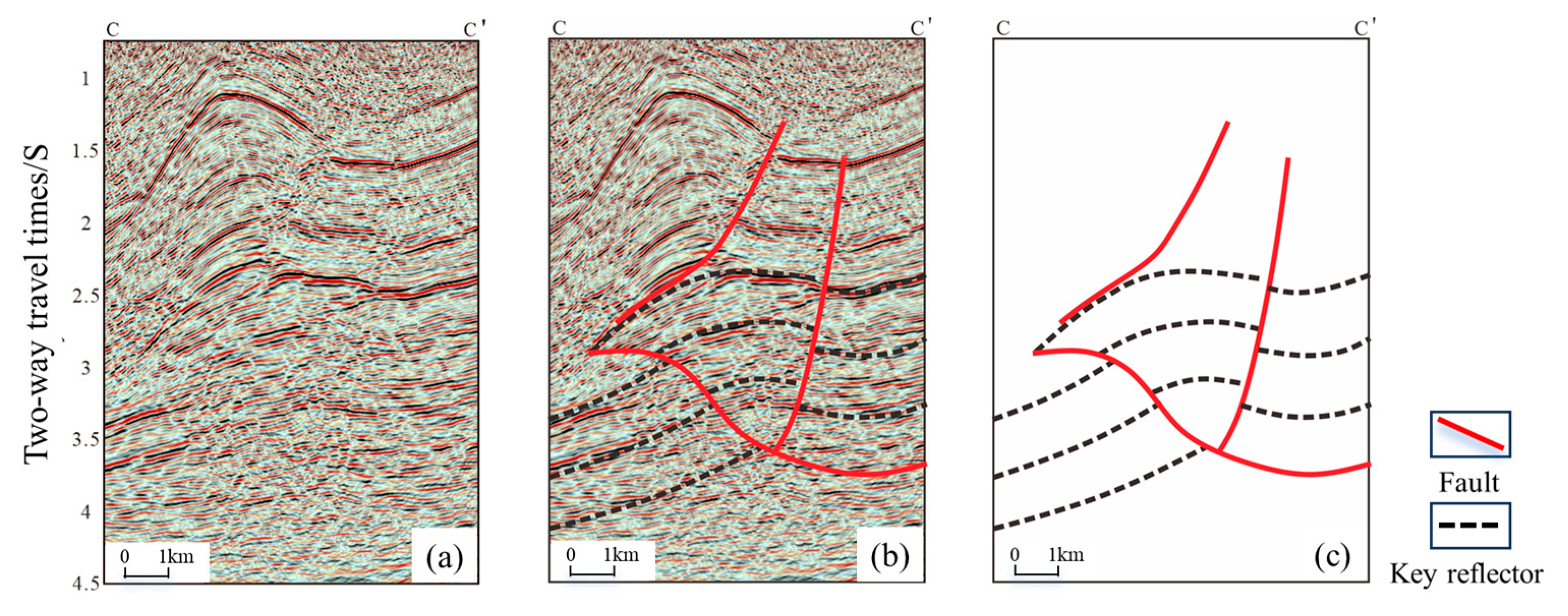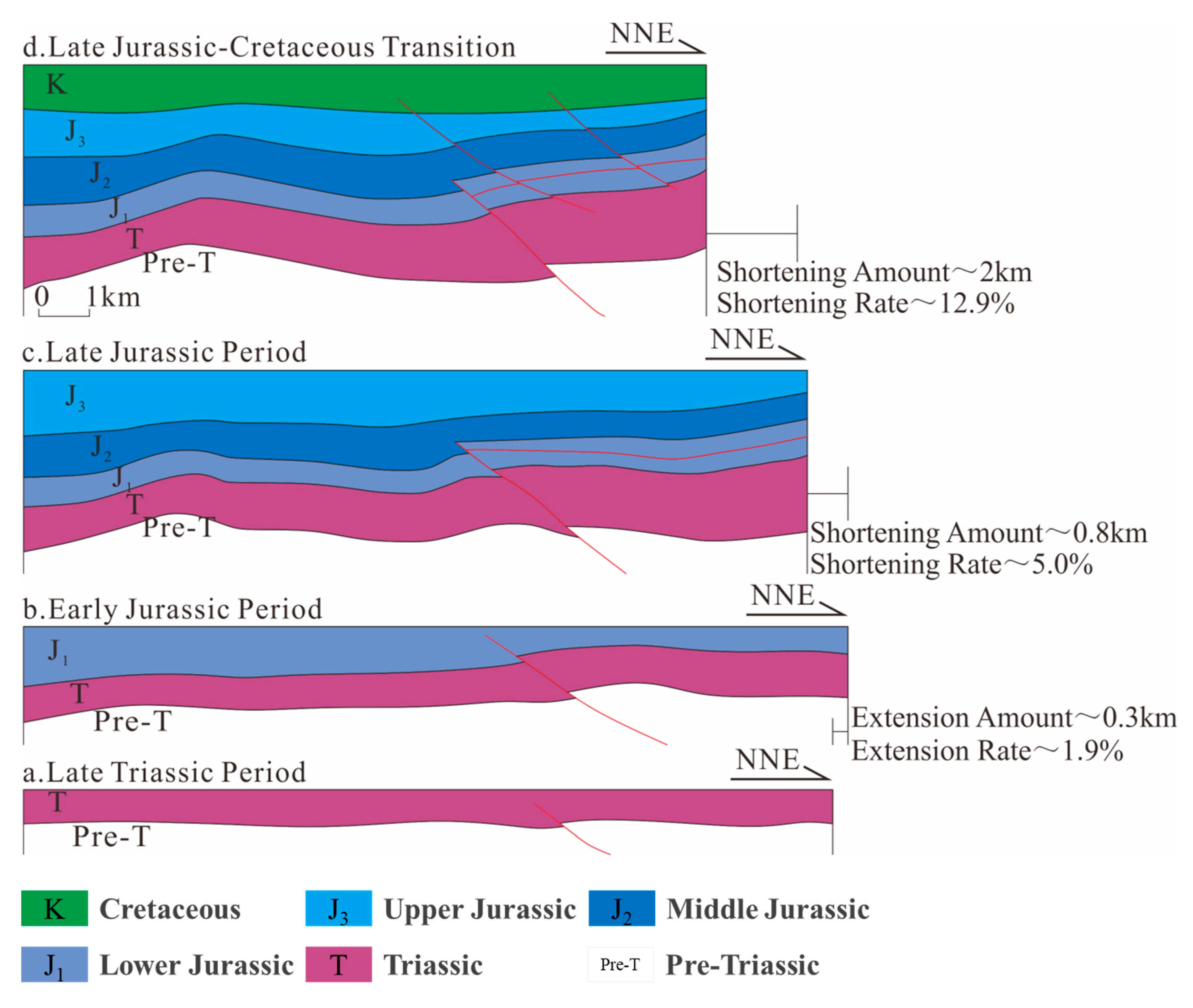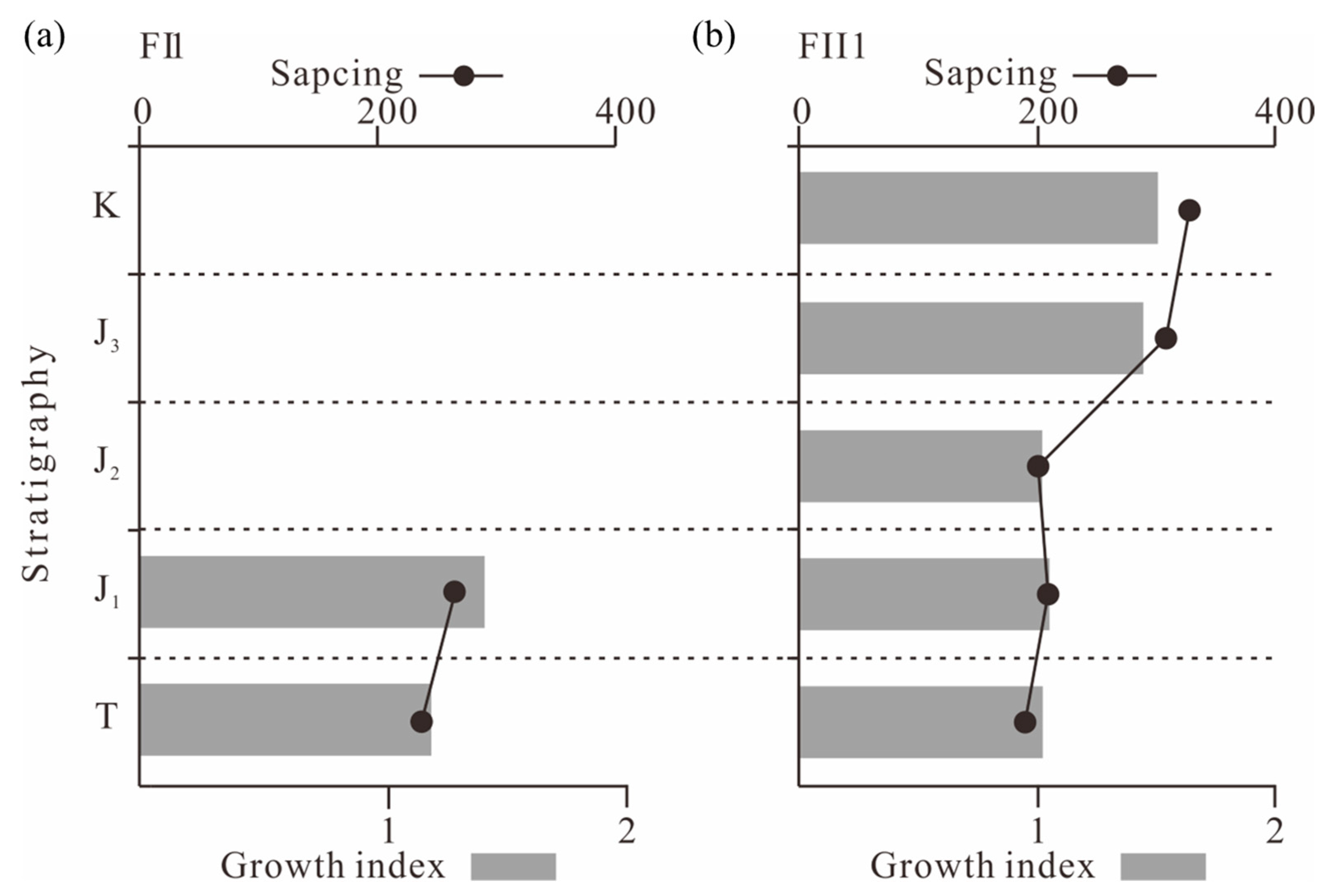Tectonic Evolution and Hydrocarbon Implications of Wedge Structures in the Central Northern Piedmont Zone, Turpan–Hami Basin
Abstract
1. Introduction
2. Geological Background
3. Data and Methods
3.1. Data
3.2. Methods
4. Results
4.1. Tectonic Deformation Characteristics
4.2. Tectonic Evolution Process
- Late Triassic Period: Initial Compressive Deformation
- Early Jurassic Period: Transition from Compression to Extension
- Late Jurassic Period: Strong Compression and Thrusting
- Late Jurassic–Cretaceous Transition: Peak of Thrusting and Wedge Formation
- Paleogene Period: Final Adjustment and Structural Stabilization
- Summary of Tectonic Evolution
5. Discussion
5.1. Analysis of Fault Activity
5.2. Petroleum Geological Significance
5.3. Exploration Implications for Structurally Similar Foreland Basins
6. Conclusions
Author Contributions
Funding
Data Availability Statement
Acknowledgments
Conflicts of Interest
References
- Jia, C.Z.; Chen, Z.X.; Lei, Y.L.; Wang, L.N.; Ren, R.; Su, N.; Yang, G. Tectonic deformation mechanisms and structural models of fold-and-thrust belts in central and western China. Earth Sci. Front. 2022, 29, 156–174. [Google Scholar]
- Chang, D.S.; Wang, G.Z.; Wen, T.M.; Li, D.S.; Hu, S.H.; Li, K.; Liu, D.M. Seismic exploration technologies and future directions for hydrocarbon detection in China’s foreland thrust belts. Acta Petrolei Sinica 2024, 45, 276–294. [Google Scholar]
- Yang, X.W.; Wang, Q.H.; Li, Y.; Lv, X.Y.; Xie, H.W.; Wu, C.; Wang, C.L.; Wang, X.; Mo, T.; Wang, R. Formation mechanism of the Bozi-Dabei trillion-cubic-meter gas area in the Kuqa foreland thrust belt. Earth Sci. Front. 2022, 29, 175–187. [Google Scholar]
- Yang, K.; Qi, J.; Shen, F.; Sun, T.; Duan, Z.; Cui, M.; Lv, J. Formation Mechanism of Salt Piercement Structures in a Compressive Environment: An Example from the Kuqa Depression, Western China. J. Struct. Geol. 2024, 178, 105005. [Google Scholar] [CrossRef]
- Wen, C.; Wang, Z. Formation and Evolution of Multi-Genetic Overpressure and Its Effect on Hydrocarbon Accumulation in the Dabei Area, Kuqa Depression, Tarim Basin, China. Energies 2024, 17, 6263. [Google Scholar] [CrossRef]
- Du, J.H.; Zhi, D.M.; Li, J.Z.; Yang, D.S.; Tang, Y.; Qi, X.F.; Xiao, L.X.; Wei, L.Y. Major discovery of the Gaotan-1 well and exploration prospects in the lower assemblage of the southern Junggar Basin. Pet. Explor. Dev. 2019, 46, 205–215. [Google Scholar] [CrossRef]
- Pang, Z.C.; Ji, D.S.; Liu, M.; Shi, L.; Li, J.; Gao, Z.Y.; Wei, L.Y.; Wang, J.; Ding, Y.C. Hydrocarbon accumulation conditions and exploration potential of the Jurassic–Cretaceous in the southern Junggar Basin thrust belt. Acta Petrolei Sinica 2023, 44, 1258–1273. [Google Scholar]
- Wu, Q.P.; Yang, Z.L.; Yao, J.; Yuan, C.; Zhang, J. Hydrocarbon accumulation conditions and exploration directions of the Lower–Middle Jurassic Shuixigou Formation in the northern Turpan-Hami Basin. Lithol. Reserv. 2021, 33, 1–11. [Google Scholar]
- Zhi, D.M.; Li, J.Z.; Chen, X.; Yang, F.; Liu, J.T.; Gou, H.G.; Zhang, H.; Lin, L.; Li, B.; Sun, Y.F.; et al. New exploration domains, types, and resource potential of the Turpan-Hami Basin. Acta Pet. Sin. 2023, 44, 2122–2140. [Google Scholar]
- Ma, D.L.; He, D.F.; Yuan, J.Y.; Zhang, H.Q.; Pan, S.X.; Wang, H.B.; Wang, Y.J.; Wei, C.R.; Guo, J.J. Deep geological structure and hydrocarbon-controlling roles in the southern Junggar Basin foreland thrust belt: A case study of the Huerguosi–Manas–Tugulu fold-and-thrust belt. Earth Sci. Front. 2019, 26, 165–177. [Google Scholar]
- Liang, H.; Wen, L.; Ran, Q.; Han, S.; Liu, R.; Chen, K.; Di, G.D.; Chen, X.; Pei, Y.W. Tectonic evolution and petroleum geological significance of the northern Longmen-shan foreland. Pet. Explor. Dev. 2022, 49, 478–490. [Google Scholar]
- Liu, B.; Huang, Z.L.; Tu, X.X.; Zhang, J.W.; Mu, K.X. Structural styles and hydrocarbon accumulation in the northern piedmont of the Taibei Sag, Turpan-Hami Basin. Petroleum Explor. Dev. 2011, 38, 152–158. [Google Scholar] [CrossRef]
- Yang, Z.L.; Wu, Q.P.; Huang, Y.F.; Huang, X.P. Hydrocarbon accumulation model and exploration direction in the northern thrust belt of the Turpan-Hami Basin. Nat. Gas Geosci. 2016, 27, 974–981. [Google Scholar]
- Huang, D.F.; Jiang, M.L.; Shao, M.J.; Lin, L.; Cheng, T.; Li, C.M.; Liu, J.T. Structural styles and evolution characteristics of the northern piedmont zone of the Turpan-Hami Basin. Xinjiang Pet. Geol. 2020, 41, 651–657. [Google Scholar]
- Yang, G.; Chen, Z.X.; Wang, X.B. Superimposed wedge structural model of Mingshanxia, eastern Sichuan. Geol. Rev. 2021, 67, 901–917. [Google Scholar]
- Zhou, C.; He, J.K.; Su, H.; Wang, W.M.; Wang, X.G.; Zhao, Y.J.; Jiang, Y. Discrete element modeling of distal deformation propagation in thrust wedges and implications for early deformation on the northern Tibetan and Iranian Plateaus. J. Struct. Geol. 2024, 184, 105150. [Google Scholar] [CrossRef]
- Henaish, A.; Kharbish, S.; Abdelhady, M.; Khedr, F. Fault Interactions and Role of Preexisting Structures on the Geometry of Conjugate Transfer Zones: Structural Insights from Cairo-Suez District, Egypt. Mar. Pet. Geol. 2025, 177, 107402. [Google Scholar] [CrossRef]
- Shalaby, A.; Sarhan, M.A. Origin of Two Different Deformation Styles via Active Folding Mechanisms of Inverted Abu El Gharadiq Basin, Western Desert, Egypt. J. Afr. Earth Sci. 2021, 183, 104331. [Google Scholar] [CrossRef]
- Cheng, G.; Jiang, B.; Li, M.; Li, F.; Zhu, M. Structural Evolution of Southern Sichuan Basin (South China) and Its Control Effects on Tectonic Fracture Distribution in Longmaxi Shale. J. Struct. Geol. 2021, 153, 104465. [Google Scholar] [CrossRef]
- Barbosa, G.S.; Garcia, G.G.; Pena dos Reis, R.P.B.; Garcia, A.J.V.; Barberes, G.d.A. Analysis of the Efficiency of Petroleum Systems in Fluvial Environments in the Rift Context of the South and North Atlantic: Brazil and Portugal. Geosciences 2023, 13, 239. [Google Scholar] [CrossRef]
- Barbosa, G.S.; Pena dos Reis, R.; Garcia, A.J.V.; Barberes, G.d.A.; Garcia, G.G. Petroleum Systems Analysis of Turbidite Reservoirs in Rift and Passive Margin Atlantic Basins (Brazil and Portugal). Energies 2022, 15, 8224. [Google Scholar] [CrossRef]
- Perrodon, A.; Masse, P. Subsidence, Sedimentation and Petroleum Systems. J. Pet. Geol. 1984, 7, 5–25. [Google Scholar] [CrossRef]
- Gong, D.; Cao, Z.; Ni, Y.; Jiao, L.; Yang, B.; Zhao, L. Origins of Jurassic Oil Reserves in the Turpan-Hami Basin, Northwest China: Evidence of Admixture from Source and Thermal Maturity. J. Pet. Sci. Eng. 2016, 146, 788–802. [Google Scholar] [CrossRef]
- Yuan, M.S.; Liang, S.J.; Yan, L.C. Petroleum Geology and Exploration Practice in the Turpan-Hami Basin; Petroleum Industry Press: Beijing, China, 2002; pp. 198–203. [Google Scholar]
- Xiao, D.S.; Chen, X.; Kang, J.L.; Chen, Y.H.; Liu, W.H.; Zhu, J.F.; Wei, Y.; Yang, Z.; Zhao, F.; Sun, Q.; et al. Control of Bogda Mountain tectonic evolution on hydrocarbon accumulation in the western Taibei Sag, Turpan-Hami Basin. J. Cent. South Univ. Sci. Technol. 2014, 45, 3877–3885. [Google Scholar]
- Watterson, J. Fault Dimensions, Displacements and Growth. Pure Appl. Geophys. 1986, 124, 365–373. [Google Scholar] [CrossRef]
- Zhao, G.; Zhu, R.; Si, Z.; Liu, M. The Association Between Sand Body Distribution and Fault of Zhuhai Formation on the North Slope of Baiyun Sag, Pearl River Mouth Basin, China. Appl. Sci. 2025, 15, 412. [Google Scholar] [CrossRef]
- Zeng, F.; Wang, D.; Li, Z.; Wang, W.; Dai, X.; Sun, Y.; Zhang, P. The Discovery of an Active Fault in the Qiongdongnan Basin of the Northern South China Sea. Mar. Pet. Geol. 2024, 163, 106777. [Google Scholar] [CrossRef]
- Gou, H.G.; Zhang, P.; She, J.C.; Li, Y.; Wang, X.; Liu, Z.; Sun, H.; Zhao, F.; Chen, Q.; Yang, L.; et al. Petroleum geological conditions, resource potential and exploration direction in the Turpan-Hami Basin. Mar. Orig. Pet. Geol. 2019, 24, 85–96. [Google Scholar]
- Zhen, Y.; He, D.; Chen, X.; Li, D.; Fu, G.; Guo, W. Unraveling Deformation Mechanism of the Fukang Fold-and-Thrust Belt: Insight into Intracontinental Orogenesis of the Bogda Mountain, NW China. Mar. Pet. Geol. 2024, 167, 107005. [Google Scholar] [CrossRef]
- Zhou, J.; Li, C.; Song, Z.; Zhang, X. Organic Geochemical Characteristics and Hydrocarbon Significance of the Permian System Around the Bogda Mountain, Junggar Basin, Northwest China. Sustainability 2025, 17, 347. [Google Scholar] [CrossRef]
- He, D.F. Evolution, structural framework, and hydrocarbon distribution patterns of multi-cyclic superimposed basins in China. Earth Sci. Front. 2022, 29, 24–59. [Google Scholar]
- Li, J.Z.; Chen, X.; Gong, D.Y.; Wang, Y.Z.; Zhang, C.; Liu, B.; Sun, H.; Guo, J.; Ma, S.; Zhao, F.; et al. New exploration domains and resource potential of tight sandstone gas and coalbed methane in the Turpan-Hami Basin. Acta Petrolei Sinica 2025, 46, 104–117. [Google Scholar]
- Gao, L.; Wang, X.; Rao, G. Two-dimensional balanced restoration and structural analysis of salt tectonics in western Kuqa Depression. Acta Geol. Sin. 2020, 94, 1727–1739. [Google Scholar]
- Deng, B.; Guo, H.B.; Luo, Q.; Huang, J.Q.; Yang, R.J.; Zhang, J.; Lu, P.D.; Tang, X.D.; He, Y.; Liu, S.G. Along-strike differential erosion of the Longmenshan fold-and-thrust belt: Insights from sandbox modeling. Acta Geol. Sin. 2022, 96, 840–853. [Google Scholar]
- Jia, D.; Yang, S.F.; Yin, H.W.; Li, Y.Q.; Wu, X.J.; Xie, G.A.; Li, Y.Q. Advances in physical modeling experiments of fold-and-thrust belts. Acta Geol. Sin. 2023, 97, 2896–2913. [Google Scholar]
- Allen, P.A.; Allen, J.R. Basin Analysis: Principles and Application to Petroleum Play Assessment, 3rd ed.; John Wiley & Sons: Hoboken, NJ, USA, 2013. [Google Scholar]
- Li, Q.; Li, Y.; Wang, X.; Jia, D.; Li, R.; Mao, Y. Drainage Evolution in Accretionary Thrust Systems as Responses to Tectono-Climatic Variability: Insights from Sandbox Modelling. Earth Surf. Process. Landf. 2025, 50, e70099. [Google Scholar] [CrossRef]
- Ghavri, S.; Kumar, D.; Srijayanthi, G.; Joseph, S.; Nair, T.M.; Kumar, T.S. Characterization of Source Properties of Local Earthquakes in Andaman Nicobar Islands with Particular Emphasis on Their Scaling Relationships. J. Earth Syst. Sci. 2025, 134, 39. [Google Scholar] [CrossRef]
- Dai, X.M.; Li, Z.G.; Sun, C.; Li, L.G.; Wang, W.T.; Hui, G.G.; Liang, H.; Zhang, Y.P.; Li, L.L.; Yan, Y.C.; et al. Study on three-dimensional growth and linkage processes of normal faults: A case from the Lufeng Depression, northern South China Sea. Acta Geol. Sin. 2022, 96, 1922–1936. [Google Scholar]
- Wang, L.Y.; Huang, C.; Gong, W.; Ding, W.L.; Zhao, Z. Fault characteristics and stress field disturbance analysis in the Silurian of Shunbei area, central Tarim Basin. Pet. Geol. Exp. 2024, 46, 674–682. [Google Scholar]
- Zhi, D.M.; Li, J.Z.; Chen, X.; Yang, F.; Liu, J.T.; Lin, L. Progress and potential evaluation of deep hydrocarbon exploration in the Turpan-Hami Basin. Xinjiang Pet. Geol. 2023, 44, 253–264. [Google Scholar]
- Hao, B.; Yang, Z.L.; Zhang, J.; Li, S.W.; Wei, L.H.; Shi, J.L.; Li, Z.G.; Yao, J.; Huang, X.P.; Wu, Q.P.; et al. Recognition of petroleum origin in the northern piedmont belt of the Turpan-Hami Basin and its significance. Geofluids 2022, 2022, 17–19. [Google Scholar] [CrossRef]
- Zhao, R.S.; Lu, F.; Tang, S.S.; Liu, Z.; Liu, C.L.; Liu, Z.B. Detecting Thermal Water Layer with Algorithm Model Utilizing Well-Logging Reconstruction Data: A Case Study of the Qingshankou Formation, Songliao Basin. Geothermics 2025, 131, 103388. [Google Scholar] [CrossRef]
- Roy, S.; Willingshofer, E.; Bose, S. Influence of Lateral Variations in Décollement Strength on the Structure of Fold-and-Thrust Belts: Insights from Viscous Wedge Models. J. Struct. Geol. 2024, 184, 105170. [Google Scholar] [CrossRef]
- Xu, W.; Yin, H.; Zhao, S.; Zhang, C.; Li, B.; Jia, D.; Wang, W. Influence of Multiple Detachments on Structural Vergence and Evolution of the Thin-Skinned Fold-and-Thrust Belt in the Eastern Sichuan Basin: Insights from Numerical Modeling. J. Struct. Geol. 2024, 180, 105068. [Google Scholar] [CrossRef]









Disclaimer/Publisher’s Note: The statements, opinions and data contained in all publications are solely those of the individual author(s) and contributor(s) and not of MDPI and/or the editor(s). MDPI and/or the editor(s) disclaim responsibility for any injury to people or property resulting from any ideas, methods, instructions or products referred to in the content. |
© 2025 by the authors. Licensee MDPI, Basel, Switzerland. This article is an open access article distributed under the terms and conditions of the Creative Commons Attribution (CC BY) license (https://creativecommons.org/licenses/by/4.0/).
Share and Cite
Su, K.; He, C.; Huang, J.; Liu, Z.; Hao, B.; Zhang, S.; Mu, Z.; Zhang, H.; Sun, Y. Tectonic Evolution and Hydrocarbon Implications of Wedge Structures in the Central Northern Piedmont Zone, Turpan–Hami Basin. Processes 2025, 13, 2009. https://doi.org/10.3390/pr13072009
Su K, He C, Huang J, Liu Z, Hao B, Zhang S, Mu Z, Zhang H, Sun Y. Tectonic Evolution and Hydrocarbon Implications of Wedge Structures in the Central Northern Piedmont Zone, Turpan–Hami Basin. Processes. 2025; 13(7):2009. https://doi.org/10.3390/pr13072009
Chicago/Turabian StyleSu, Kanyu, Chunbo He, Jiacheng Huang, Zongbao Liu, Bin Hao, Shiqi Zhang, Zihao Mu, Haixin Zhang, and Yue Sun. 2025. "Tectonic Evolution and Hydrocarbon Implications of Wedge Structures in the Central Northern Piedmont Zone, Turpan–Hami Basin" Processes 13, no. 7: 2009. https://doi.org/10.3390/pr13072009
APA StyleSu, K., He, C., Huang, J., Liu, Z., Hao, B., Zhang, S., Mu, Z., Zhang, H., & Sun, Y. (2025). Tectonic Evolution and Hydrocarbon Implications of Wedge Structures in the Central Northern Piedmont Zone, Turpan–Hami Basin. Processes, 13(7), 2009. https://doi.org/10.3390/pr13072009






